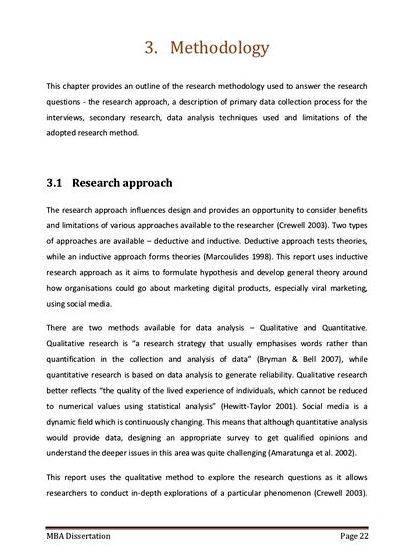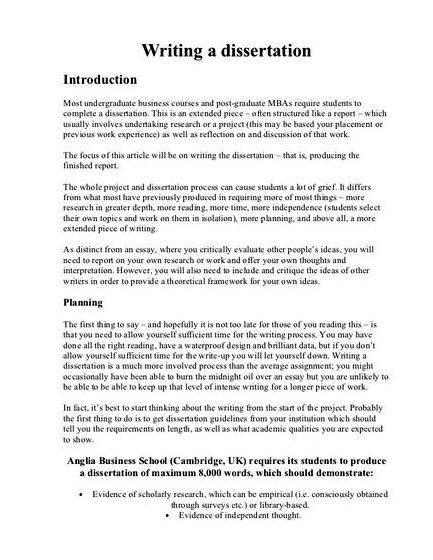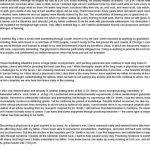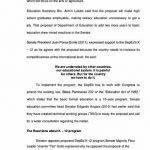A key part of your dissertation or thesis is the methodology. This is not quite the same as ‘methods’.
The methodology describes the broad philosophical underpinning to your chosen research methods, including whether you are using qualitative or quantitative methods, or a mixture of both, and why.
You should be clear about the academic basis for all the choices of research methods that you have made. ‘I was interested ‘ or ‘I thought. ‘ is not enough; there must be good academic reasons for your choice.
What to Include in your Methodology
If you are submitting your dissertation in sections, with the methodology submitted before you actually undertake the research, you should use this section to set out exactly what you plan to do.
The methodology should be linked back to the literature to explain why you are using certain methods, and the academic basis of your choice.
If you are submitting as a single thesis, then the Methodology should explain what you did, with any refinements that you made as your work progressed. Again, it should have a clear academic justification of all the choices that you made and be linked back to the literature.
Common Research Methods for the Social Sciences
There are numerous research methods that can be used when researching scientific subjects, you should discuss which are the most appropriate for your research with your supervisor.
The following research methods are commonly used in social science, involving human subjects:
Interviews
One of the most flexible and widely used methods for gaining qualitative information about people’s experiences, views and feelings is the interview.
An interview can be thought of as a guided conversation between a researcher (you) and somebody from whom you wish to learn something (often referred to as the ‘informant’).
The level of structure in an interview can vary, but most commonly interviewers follow a semi-structured format. This means that the interviewer will develop a guide to the topics that he or she wishes to cover in the conversation, and may even write out a number of questions to ask.
However, the interviewer is free to follow different paths of conversation that emerge over the course of the interview, or to prompt the informant to clarify and expand on certain points. Therefore, interviews are particularly good tools for gaining detailed information where the research question is open-ended in terms of the range of possible answers.
Interviews are not particularly well suited for gaining information from large numbers of people. Interviews are time-consuming, and so careful attention needs to be given to selecting informants who will have the knowledge or experiences necessary to answer the research question.
See our page: Interviews for Research for more information.
Observations
If a researcher wants to know what people do under certain circumstances, the most straightforward way to get this information is sometimes simply to watch them under those circumstances.
Observations can form a part of either quantitative or qualitative research. For instance, if a researcher wants to determine whether the introduction of a traffic sign makes any difference to the number of cars slowing down at a dangerous curve, she or he could sit near the curve and count the number of cars that do and do not slow down.

Because the data will be numbers of cars, this is an example of quantitative observation.
A researcher wanting to know how people react to a billboard advertisement might spend time watching and describing the reactions of the people. In this case, the data would be descriptive. and would therefore be qualitative.
There are a number of potential ethical concerns that can arise with an observation study. Do the people being studied know that they are under observation? Can they give their consent? If some people are unhappy with being observed, is it possible to ‘remove’ them from the study while still carrying out observations of the others around them?
Questionnaires
If your intended research question requires you to collect standardised (and therefore comparable) information from a number of people, then questionnaires may be the best method to use.
Questionnaires can be used to collect both quantitative and qualitative data, although you will not be able to get the level of detail in qualitative responses to a questionnaire that you could in an interview.
Questionnaires require a great deal of care in their design and delivery, but a well-developed questionnaire can be distributed to a much larger number of people than it would be possible to interview.
Questionnaires are particularly well suited for research seeking to measure some parameters for a group of people (e.g. average age, percentage agreeing with a proposition, level of awareness of an issue), or to make comparisons between groups of people (e.g. to determine whether members of different generations held the same or different views on immigration).
See our page: Surveys and Survey Design for more information.
Documentary Analysis
Documentary analysis involves obtaining data from existing documents without having to question people through interview, questionnaires or observe their behaviour. Documentary analysis is the main way that historians obtain data about their research subjects, but it can also be a valuable tool for contemporary social scientists.
Documents are tangible materials in which facts or ideas have been recorded. Typically, we think of items written or produced on paper, such as newspaper articles, Government policy records, leaflets and minutes of meetings. Items in other media can also be the subject of documentary analysis, including films, songs, websites and photographs.
Documents can reveal a great deal about the people or organisation that produced them and the social context in which they emerged.
Some documents are part of the public domain and are freely accessible, whereas other documents may be classified, confidential or otherwise unavailable to public access. If such documents are used as data for research, the researcher must come to an agreement with the holder of the documents about how the contents can and cannot be used and how confidentiality will be preserved.
How to Choose your Methodology and Precise Research Methods
Your methodology should be linked back to your research questions and previous research.
Visit your university or college library and ask the librarians for help; they should be able to help you to identify the standard research method textbooks in your field. See also our section on Research Methods for some further ideas.
Such books will help you to identify your broad research philosophy, and then choose methods which relate to that. This section of your dissertation or thesis should set your research in the context of its theoretical underpinnings.
The methodology should also explain the weaknesses of your chosen approach and how you plan to avoid the worst pitfalls, perhaps by triangulating your data with other methods, or why you do not think the weakness is relevant.
For every philosophical underpinning, you will almost certainly be able to find researchers who support it and those who don’t.
Use the arguments for and against expressed in the literature to explain why you have chosen to use this methodology or why the weaknesses don’t matter here.
Structuring your Methodology
It is usually helpful to start your section on methodology by setting out the conceptual framework in which you plan to operate with reference to the key texts on that approach.
You should be clear throughout about the strengths and weaknesses of your chosen approach and how you plan to address them. You should also note any issues of which to be aware, for example in sample selection or to make your findings more relevant.
You should then move on to discuss your research questions, and how you plan to address each of them.
This is the point at which to set out your chosen research methods, including their theoretical basis, and the literature supporting them. You should make clear whether you think the method is ‘tried and tested’ or much more experimental, and what kind of reliance you could place on the results. You will also need to discuss this again in the discussion section.
Your research may even aim to test the research methods, to see if they work in certain circumstances.
You should conclude by summarising your research methods, the underpinning approach, and what you see as the key challenges that you will face in your research. Again, these are the areas that you will want to revisit in your discussion.
Conclusion
Your methodology, and the precise methods that you choose to use in your research, are crucial to its success.
It is worth spending plenty of time on this section to ensure that you get it right. As always, draw on the resources available to you, for example by discussing your plans in detail with your supervisor who may be able to suggest whether your approach has significant flaws which you could address in some way.
The following article is a sample dissertation methodology on the following dissertation topic: Impact of Technology on Recruitment in UK Retail Banks: A case study of Lloyds Banking Group.
The methodology depicts a mixed method research, using quantitative surveys and semi structured interviews.
Table of Contents
a. Research Philosophy:
The social world of banks and graduates upon which this study is based exists externally and are not related to the researcher; therefore they would be measured through objective methods rather than being inferred subjectively through reflection, sensation or intuition (Easterby-Smith, 2002). This study would therefore adopt a positivist approach as credible data could only be derived through quantitative analysis of phenomena observed (Saunders et al, 2007). The social interpretivism philosophy, which aims to study and reflect on the inner feelings of participants, is not being utilized in this study, due to the study’s research objective, which is to ascertain the effectiveness of online recruitment in an organization. Details regarding effectiveness are measured using objective means (such as increase in candidate application and reduction in costs), thereby warranting a positivist approach.
b. Research approach
Due to the positivist nature of the research, this study would adopt a deductive approach (Saunders et al, 2007). This approach represents the most common view of the relationship between theory and research and results gotten from this approach are developed through logical reasoning (Bryman and Bell, 2007). The data findings would be compared against existing literature to ascertain if they concur with what has already been published in the field of online recruitment.
c. Access
The ability to gather primary data during this study was dependent on gaining access to an appropriate source within the organization. The level to which this source is appropriate relies on the research question, related objectives and research designs (Saunders et al, 2007). Therefore, the researcher, as a friend of an employee within the organization, was in a favorable position to get access within the organization.
I contacted a friend of mine who currently works within graduate recruitment at Lloyds TSB, and discussed the prospects of my dissertation. She spoke to several of her colleagues on my behalf and they agreed for me to conduct telephone interviews with 4 members of the graduate recruitment team, some of which had been there for an average of 5 – 10 years (reasons expatiated further in this chapter). Due to the non-intrusive nature of my research, there were no objections or limitations raised by the participants with regards to the questions asked or the purpose of the study.
d. Research Strategy
This study would adopt a case study strategy in answering the research question. Robson (2002) asserts that the case study strategy would be useful if the aim of the study is to gain a rich understanding of the research perspective and the process being endorsed. Therefore as this study aims to understand the recruitment process within Lloyds TSB and also any benefits associated with online recruitment, a case study would be most effective.
Two separate yet parallel approaches would be utilized in this study, and are outlined in the table 1 below.
Table 1: Research Strategy
i. Quantitative Questionnaire
Quantitative methods are mainly used in the data collection process of research. It involves data that is either in the form of, or expressed as numbers (Easterby-Smith et al, 2008). The quantitative questionnaires were handed out to 10 graduates and undergraduates. The questionnaire was mainly designed with rating scale questions, where respondents were asked to state their opinion or preference for a particular question on a scale of 1 – 5. Secondary nominal data was also included in order to ascertain the respondent’s status, application activity and preference. The quantitative questionnaire distributed to respondents is outlined in appendix. Quantitative questionnaires are useful as the results derived are quantifiable and measurable against other variables in an objective manner (Saunders et al, 2007).
ii. Qualitative Semi Structured Interviews
Following the access grant to four members of the recruitment team within the organization, 15 – 20 minute qualitative telephone interviews were carried out. A semi-structured interview is a qualitative interview that is defined by a pre-set question guide. It aims to provide in-depth findings through informal discussions with participants (Collis and Hussey, 2003). This interview method was chosen over unstructured or structured interviews, because this study intends to answer the research questions by asking specific questions, but not so much (unstructured) that it generates useless data, and not so less (structured) so as not to miss out on any unanticipated information.
The interview questions in the semi-structured interview are in appendix. The themes utilized in this study were derived mainly from the literature review and were crucial in developing the questions that were raised during the study. The semi-structured approach also provided the researcher with the ability to probe answers. Answer probing was particularly useful in responses whereby more explanation was needed in order to fully understand the answers. Due to the recent adaptation of online recruitment, the semi structured interviews was targeted at members of the team who had witnessed or orchestrated the shift towards online recruitment, that way these respondents would be better able to answer questions that relate to the comparison of both methods.
Also, members of the online recruitment team being interviewed had different positions within recruitment and handled separate tasks. The questionnaires were given to them beforehand, when the approval was first sought, and each respondent chose the questions that they were more qualified to respond to. Therefore the research was such that all respondents answered some questions, while some others were answered by a particular individual because of their knowledge of that process. Table 2 outlines the respondent details and their interview theme.
Table 2: Interview Respondents and Questions asked
Each respondent were asked for their consent to interview, prior to the interview sessions, and also requested not to have their names mentioned so as to prevent any form of organizational backlash if the contents of the study were interpreted in any other non-academic form, and distributed. They have therefore been given fictional names, so as to make the research more readable.
e. Data Collection
i. Sampling Method
Based on the research objectives and the issues to be investigated, it would have been most appropriate if all recruitment staffs within the organization were interviewed. However, due to the time constraints and resource limitations inherent in this study, a non-probability sample of the population was selected. Saunders et al (2007) asserts that a non-probability sample is most often used when adopting a case study strategy. A non-probability sample, as described by (Oppenheim, 2000), is a sample in which the probability of each case being selected from the total population is not known.
The samples of graduates that were chosen to partake in the quantitative study are too small to constitute a probability sample of graduates within London or UK. Also, the number of employees within Lloyds who took part in the qualitative study was not high enough to constitute a significant portion of the recruitment department within Lloyds TSB. Therefore the study focused more on the quantitative facts of the perception of recruitment within the organization, as opposed to theories expressed in the literature review, and what graduates on the outside thought of online recruitment.
ii. Primary Data Collection
In collecting data that could be analysed using quantitative means, Easterby-Smith et al (2008) claims that researchers could collect either primary or secondary data. He further claims that though each of these means have their merits and demerits, the collection of one’s own data gives control over the structure of the sample and the data obtained from each respondent. It also gives greater confidence that the data collected would match the research objectives.
The researcher therefore chose to collect primary data from 20 graduates using questionnaires distributed-in-person to each respondent. This was done amongst friends and colleagues within the university who have utilized online recruitment systems. Data from the semi-structured interviews would be collected using a tape recorder, and the conversations with all four employees would be transcribed word for word, and expression for expression. The advantages inherent in this approach is that it allows the researcher to document and see patterns in words and emotions that would not be available if other forms of interviews were conducted.
f. Analysis of Research Findings
i. Quantitative Data
The quantitative data collected during the course of this study, whilst still in its raw form, is described by Saunders et al (2007) as being useless and conveying little information to most people. Univariates, which are total sample distributions of one variable at a time (Oppenheim, 2005) was utilised in analysing the frequency and percentage occurrence of each variable; including both ordinal and nominal, category and rating scale questions. However an indepth correlation or bivariate analysis was not conducted due to the low number of graduate respondents, and also due to the fact that the study was mainly concerned with the viewpoint of the organization, and not necessarily that of the graduates. Results would be analysed using Excel and graphs would be drawn out to analyse all data with the aim of comparing them to the qualitative study.
ii. Qualitative Data
Yin (2002) suggests that in studies whereby the research question has been formulated based on the literature review; these theories that have been used in the postulation of the research question could also be used in analyzing the findings. Thereby suggesting that a deductive approach to data analysis would be essential for theoretical driven studies.
Based on these arguments, this study analyzed the qualitative findings using deductive methods. The findings from each respondent and questionnaire theme were analyzed according to the literature review topics discussed. In the instance whereby different respondents had something to say about a particular issue, all their opinions were recorded and taking into consideration in the analysis of findings. A fact sheet of all findings according to the theory is illustrated in chapter 4. Full transcripts of the interview are in the appendix.
The pattern matching procedure, as postulated by Saunders et al, (2007), would be utilized in this deductive analysis. It involves predicting a pattern of outcomes based on theoretical propositions. These propositions are thereby analyzed in the data analysis process. This procedure involves the development of an analytical framework, utilizing existing theory, and then testing the adequacies of the framework as a means of explaining the findings (Saunders et al, 2007). In the instance where a pattern is found as initially predicted, it would be evidence that suggests that there is indeed an explanation for findings.
g. Ethics
Blumberg, et al (2005) describes ethics as referring to the appropriateness of one’s behaviour in relation to the rights of those who become the subject of a research project. A number of ethical issues have been identified and raised with respect to this study. The issues, and steps taken to alleviate such issues are discussed below:
- The company may be secretive about some aspects of its online recruitment, such as the quantity of graduates and marketing techniques to attract graduates, which it may not like its competitors to know about.
- Employees responding to semi structured interviews may not be so willing to discuss their personal opinion of the bank’s recruitment system, or the quality of graduates received through their channels, in case their response does not really conform to the brand and reputation that the organization is trying to build (for instance, the bank may pose as an equal opportunity organization that employs from diverse backgrounds, whereas they mostly only recruit students from top Oxbridge universities with a certain background). Information such as this could pose difficulties if the bank eventually decides to broaden its pool of candidates and employ people from varying backgrounds.
Apart from these ethical considerations, no other ethical dilemmas have been found with relation to this essay. Therefore, in order to alleviate these issues, the questionnaire and interviews would be designed in such a way that it does not offend, harm, provoke or stress any of the participants in any way. Questions asked would be non-instrusive as no personal information about names; age or post would be requested. Information about specific applicant quality and demographics of applicants’ recruitment would not be sought.
Also, in terms of graduate questionnaires that have been distributed, some candidates may think that answering these questions and including personal details may impede or even benefit them when applying to said organizations. Therefore the questionnaires would fully state that it is an academic research and in no way constitutes a study conducted by the organization.
h. Limitations
- The major limitation of this research would be gaining access to graduates who have gone through online recruitment systems and applied specifically to Lloyds TSB. Graduates that have applied to the bank are diverse both in culture and geography. Therefore this study would be limited in not being able to survey a probability sample of graduates who have either used online recruitment or specifically applied to Lloyds TSB in the past.
- The willingness and capacity of staff to answer questions with relation to graduate recruitment is also impeded. Some staff may not be willing to discuss sensitive issues such as their views, some may be unwilling to discuss online recruitment in any capacity to an external researcher such as myself, while some may not have the relevant experience required to answer most of the questions raised in this study. Therefore the list of participants has been limited to 4, which in no way represents a probability sample of the recruitment workforce within the organization.
- There is also a secondary limitation with regards to the experience of those staff that participate in the interviews. The ideal participants would typically have been working in recruitment for over 10 years, and would have witnessed and participated in the transition from traditional to online recruitment within the organization. However, only two of the participants answering this questionnaire are ‘ideal candidates’, the other 2 have been working within recruitment over the past 2 – 3 years and were in no capacity to discuss the transition between traditional and online recruitment. However, their views were still helpful and contributed significantly to the findings of this study.
- This study did not incorporate recent events such as the merger between Lloyds TSB and HBOS. It also did not include the recent government bailout and financial crisis affecting most UK financial institutions. This information could have impacted on the quality of graduate applications that the organization received within the past 3 years, and could pose a shortfall in the information gathered. However, including this information would have extended the limits of the study, beyond the word count and capacity currently accepted.






 Declaration of sentiments and resolutions thesis writing
Declaration of sentiments and resolutions thesis writing Pre-proposal for your masters thesis in education
Pre-proposal for your masters thesis in education Organic rankine cycle phd thesis writing
Organic rankine cycle phd thesis writing Doctorat d etat thesis writing
Doctorat d etat thesis writing Writing your thesis introduction of hotel
Writing your thesis introduction of hotel






